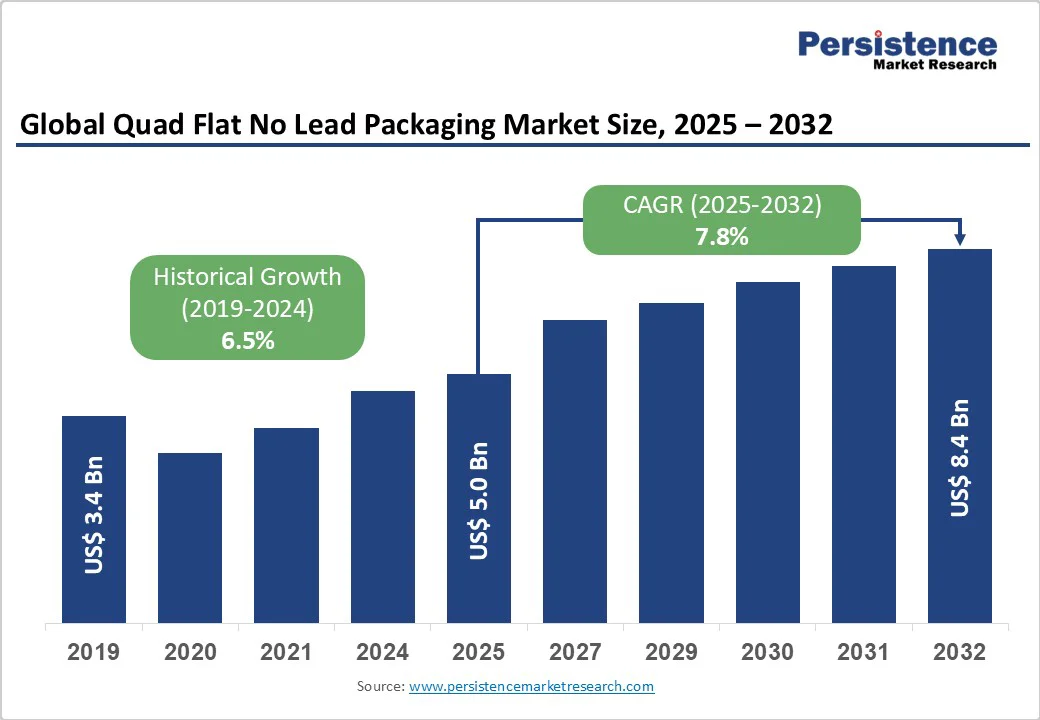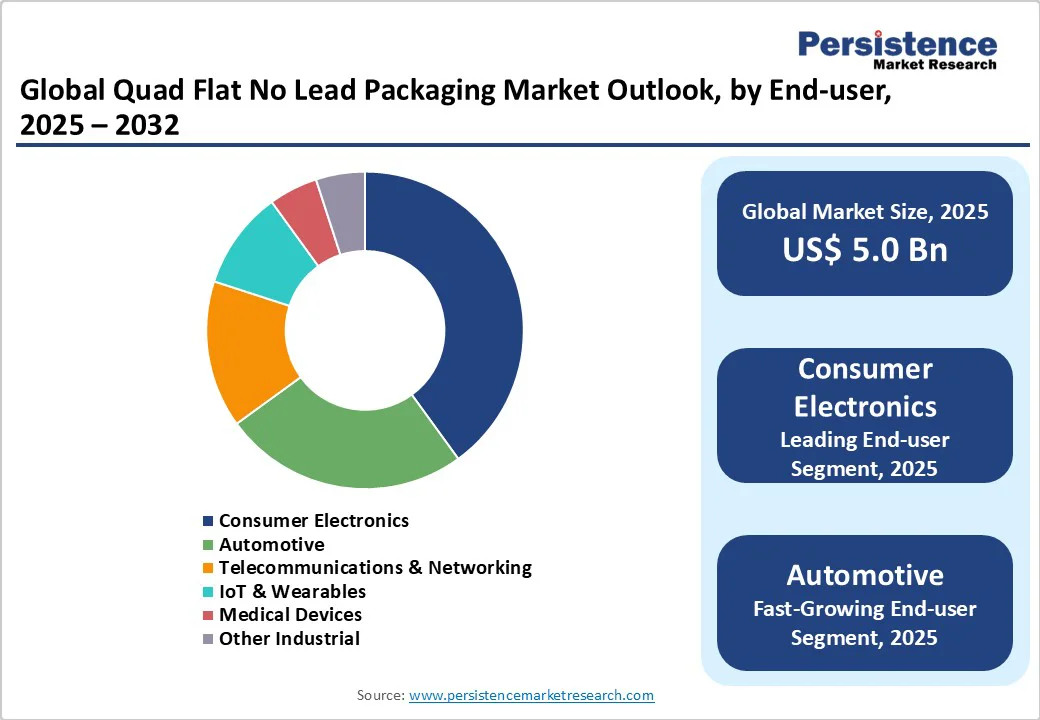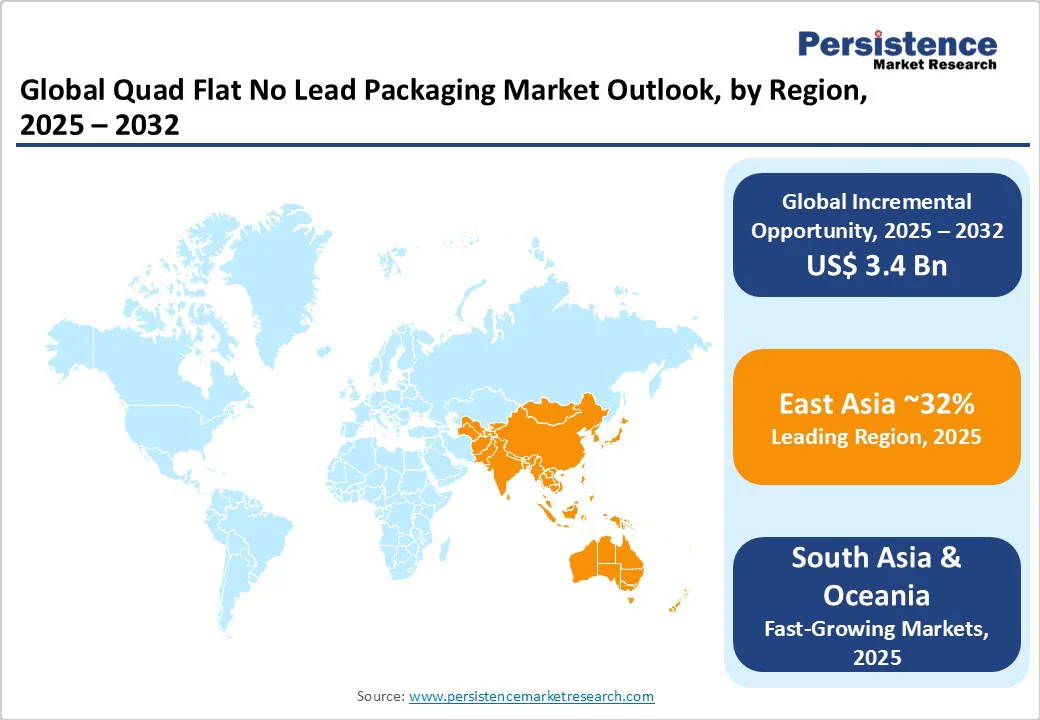ID: PMRREP35779| 186 Pages | 27 Oct 2025 | Format: PDF, Excel, PPT* | Semiconductor Electronics

The global quad flat no-lead (QFN) packaging market size is likely to be valued at US$ 5.0 billion in 2025, and is projected to reach US$ 8.4 billion by 2032, growing at a CAGR of 7.8% during the forecast period 2025 - 2032.
This robust growth trajectory reflects the sector's critical role in supporting the miniaturization of electronics around the world, with QFN packages becoming increasingly essential for space-constrained applications where thermal management and electrical performance are paramount.
The market demonstrates strong momentum driven by the proliferation of consumer electronics, automotive electrification, and the rapid deployment of 5G infrastructure, which collectively demand compact, high-performance packaging solutions.
| Key Insights | Details |
|---|---|
| Quad Flat No-Lead (QFN) Packaging Market Size (2025E) | US$ 5.0 Bn |
| Market Value Forecast (2032F) | US$ 8.4 Bn |
| Projected Growth (CAGR 2025 to 2032) | 7.8% |
| Historical Market Growth (CAGR 2019 to 2024) | 6.5% |

The relentless pursuit of smaller, more powerful electronic devices represents the primary catalyst propelling QFN market expansion. Modern consumer electronics, particularly smartphones and wearables, require packaging solutions that maximize functionality within increasingly constrained spaces.
According to industry data, IoT devices are expected to surpass 30 billion units by 2025. This miniaturization imperative extends beyond consumer electronics into automotive, industrial automation, and medical devices, where compact form factors enable new product categories and enhanced integration of functionality.
The global 5G network rollout necessitates advanced packaging solutions capable of handling high-frequency operations with minimal signal degradation. QFN packages demonstrate superior RF performance characteristics, featuring reduced parasitic inductance and enhanced signal integrity compared to traditional leaded packages.
The exposed thermal pad design facilitates efficient heat dissipation, crucial for 5G base stations and wireless communication equipment. Industry projections indicate global 5G connections will exceed 1.5 billion by 2025, driving substantial demand for RF-capable QFN packages in telecommunications infrastructure.
The QFN packaging market faces significant supply chain constraints, particularly in leadframe procurement from specialized suppliers. Market consolidation has reduced the number of leadframe manufacturers, creating supply bottlenecks during demand surges.
The leadframe business operates on low margins, causing some suppliers to exist in the market and creating periodic shortages that impact QFN production capacity. These supply chain vulnerabilities can lead to extended lead times and increased costs, particularly affecting smaller packaging houses with limited supplier relationships.
The manufacturing process of quad flat no-lead packages requires precise control over multiple variables, including void formation, solder paste volume, and thermal via design to ensure reliable performance. The large coverage area and numerous thermal vias in QFN packages create challenges for achieving consistent solder joint quality, with void control being particularly critical for thermal performance. Manufacturing complexities increase with higher pin counts and advanced features, requiring specialized equipment and processes that represent significant capital investments for packaging houses.
Developing economies, particularly in Asia Pacific, present substantial growth opportunities as electronics manufacturing capacity expands globally. Government initiatives in India, such as the Production Linked Incentive (PLI) schemes that have allocated massive financial resources for electronics manufacturing, have created favorable investment environments for QFN adoption.
On the other hand, China's semiconductor packaging market expansion, supported by domestic policy initiatives, offers significant potential for QFN technology deployment. These emerging markets combine cost advantages with growing technical capabilities, creating attractive opportunities for QFN package manufacturers to establish local production and serve regional demand.
Furthermore, continuous advancement in leadframe materials, including enhanced copper alloys with improved thermal conductivity and reduced oxidation properties, creates opportunities for superior QFN package performance.
Innovations in surface treatments such as Palladium-Nickel coatings and Pre-Plated Frame technologies improve solderability and corrosion resistance, expanding QFN applications into high-reliability sectors. The development of thinner, multi-layer leadframes and embedded passive component integration enables more complex circuit designs within compact form factors, opening new application possibilities in advanced electronic systems.
Plastic QFN (PQFN) is expected to dominate the market with an estimated 60% share in 2025, primarily due to its cost-effectiveness and versatility across mass-market applications. PQFN packages excel in consumer electronics applications, with over 50% of smartphones globally utilizing plastic-molded QFNs in 2023.
The manufacturing efficiency and scalability of plastic molding processes make PQFN ideal for high-volume production scenarios, particularly in portable devices, IoT sensors, and smart home applications. Plastic encapsulation provides adequate environmental protection while maintaining competitive pricing for consumer-focused applications.
Air-cavity QFN (AC QFN) is set to be the fastest-growing segment in 2025, driven by its superior thermal management capabilities and enhanced electrical performance for specialized applications. AC QFN packages feature reduced parasitic capacitance and inductance compared to plastic variants, making them particularly suitable for high-frequency RF applications and wireless communication systems.
The air gap design facilitates improved heat dissipation, essential for high-power applications in automotive electronics and 5G infrastructure equipment.
Consumer electronics is poised to lead demand with around 40% of the quad flat no-lead packaging market revenue share in 2025, reflecting the sector's massive scale and continuous innovation cycles. The segment encompasses smartphones, tablets, wearables, and smart home devices that collectively drive high-volume QFN consumption.
Consumer electronics applications particularly value QFN's compact footprint and thermal efficiency, enabling thinner device profiles and longer battery life. The rapid adoption of advanced features in consumer devices, including AI processing capabilities and 5G connectivity, sustains strong demand for high-performance QFN packages.
Automotive emerges as the fastest-growing segment in 2025, driven by vehicle electrification and advanced driver assistance systems (ADAS) integration. Electric vehicle (EV) adoption and autonomous driving technologies require numerous electronic control units utilizing QFN packages for space efficiency and reliability.
Automotive applications demand QFN packages capable of withstanding extreme temperature variations and vibration conditions while maintaining consistent performance. Interestingly, the transition of the automotive industry toward smart, connected vehicles creates substantial growth opportunities for QFN suppliers.

Asia Pacific is predicted to dominate the quad flat no-lead packaging market share in 2025 in terms of production and consumption, with China representing the largest manufacturing base for consumer electronics and automotive components. Japan's automotive industry, generating 63 trillion yen in shipments while supporting over 5.58 million jobs, creates substantial demand for QFN packages in automotive electronics.
The regional market also benefits from integrated supply chains combining semiconductor fabrication, packaging, and assembly capabilities, enabling cost-effective QFN production for global markets. China's semiconductor policy initiatives and domestic market expansion support continued QFN market growth in the region.
North America is anticipated to maintain a strong position in advanced QFN applications, particularly in automotive electronics and 5G infrastructure deployment. The regional market makes substantial gains from major semiconductor companies such as Texas Instruments, which are investing billions in semiconductor fabs, creating an enormous demand for advanced packaging solutions.
Government initiatives, including the CHIPS and Science Act, provide robust support for domestic semiconductor manufacturing, with companies such as Amkor Technology expanding its facilities within the U.S. Moreover, the domestic automotive sector's rapid electrification, with U.S. new car sales incorporating increasing EV content, drives QFN adoption in power management and control systems.
Europe focuses on automotive and industrial applications, with Germany's automotive industry representing over 30% of European passenger car production and maintaining strong export capabilities.
The region's emphasis on premium automotive segments, where German original equipment manufacturers (OEMs) control nearly 60% of global premium vehicle production, has generated a massive demand for high-reliability quad flat no-lead packages in advanced electronic systems.
European regulatory initiatives supporting 5G infrastructure development and automotive electrification offer growth catalysts for QFN adoption in telecommunications and automotive applications.

The global quad flat no-lead packaging market exhibits a consolidated structure dominated by major semiconductor packaging service providers. Leading players include ASE Technology, Amkor Technology, JCET Group, Powertech Technology, and Tongfu Microelectronics, representing the top-tier companies with comprehensive QFN manufacturing capabilities.
Market concentration reflects the capital-intensive nature of advanced packaging operations and the technical expertise required for high-volume QFN production. Competitive positioning emphasizes technological capability, manufacturing scale, and customer relationship strength across diverse end-market applications.
The global quad flat no-lead (QFN) packaging market is projected to reach US$ 5.0 billion in 2025.
The widespread miniaturization of electronics around the world and the intensifying need for advanced packaging solutions for space-constrained applications where thermal management and electrical performance are driving the market.
The market is poised to witness a CAGR of 7.8% from 2025 to 2032.
Key market opportunities include expanding electronics manufacturing in emerging economies supported by government incentives and advancements in QFN materials and thermal management technologies for high-reliability applications.
ASE Technology, Amkor Technology, JCET Group, Powertech Technology, and Tongfu Microelectronics are some major players.
| Report Attribute | Details |
|---|---|
| Forecast Period | 2025 to 2032 |
| Historical Data | 2019 to 2024 |
| Market Analysis | Value: US$ Bn/Mn, Volume: As Applicable |
| Region Covered |
|
| Segmental Coverage |
|
| Key Companies Covered |
|
| Report Coverage |
|
By Package Type
By Manufacturing Method
By End-use
By Region
Delivery Timelines
For more information on this report and its delivery timelines please get in touch with our sales team.
About Author